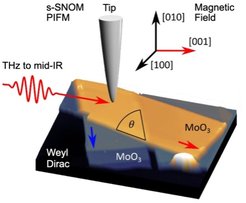Nanoscopy of Topological Phases in Polaritonic Media
Can the ground state properties of solid-state materials be modified within the strong-coupling regime of quantum electrodynamics, or to phrase it more vividly: Is it possible to modify topological transport processes through the judicious design of the electromagnetic density of states in hybridized light-matter fields?

Initially, from the perspective of solid-state physics, this might sound audacious. However, considering that the electromagnetic (gauge) field provides the indispensable background on which any topological condensed matter physics plays out, it naturally prompts the question of how the distinct transport characteristics of topological fermion phases can be altered within confined polariton fields.
The primary objective of this PhD thesis project is to advance the current understanding on polariton modes in Dirac and Weyl semimetals that host topological surface and edge states. As many polar excitations in topological condensed matter phases lie in the THz to mid-IR regime, we have developed custom-built tools for probing polariton fields in the so-called THz-gap (0.1-10 THz), extending to cryogenic conditions (4 - 300 K), and under the influence of high-magnetic fields (up to 7 T). As an innovative approach, this project aims to employ these tools and novel imaging techniques for the spatial-spectral-temporal characterization of polaritonic spin-momentum textures using scattering scanning near-field optical microscopy [1,2] and photo-modulated force microscopy [3].
The second objective will evolve around the design and fabrication of tunable hyperbolic phonon polariton cavities [4] capable of hybridizing with fermionic surface and edge states found within geometrically structured Dirac and Weyl semimetal single crystal substrates. A central challenge will be the development of inventive device structures that establish a correlation between the real-space geometric phase manipulation of cavity modes and the non-local detection of polariton-induced charge and heat currents though topological surface and edge states.
This PhD project will be jointly conducted between TU Dresden and MPI CPFS. It is ideal for students with a solid background in condensed matter physics and a strong interested in hands-on experimentation.












